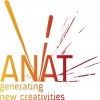Since 1988 ANAT has been working with artists who make artwork with personal computers, yet despite a promise of intimacy, unique identity, and immediacy these computers haven’t always been so personal.  Most computer artworks sat on desks and plinths and elicited interaction with only a fraction of their audiences. Smaller and faster computers like mobile phones, PDAs and Play Station Portables have made site-specific locative works possible and taken game playing back into the street, but the familiar and repetitive user button pushing paradigms persist.
Most computer artworks sat on desks and plinths and elicited interaction with only a fraction of their audiences. Smaller and faster computers like mobile phones, PDAs and Play Station Portables have made site-specific locative works possible and taken game playing back into the street, but the familiar and repetitive user button pushing paradigms persist.
Wearable computing brings a fresh approach to how a computer can be used. Just like watches, glasses and protective clothing, a person’s computer should be worn and used as an intelligent assistant, as an enhancement of our daily lives. The literal sea of communication, sensing and surveillance networks in which we exist form a supportive electronic net, which means wherever we go (mostly) we are always in touch, in sight, in sound.
To investigate these creative possibilities ANAT, in partnership with Craft Australia and the Australian National University’s School of Art and Centre for New Media Arts (CNMA), are staging reSkin – the first Australian Wearable Technology Research and Development Laboratory. reSkin, an intensive three-week residential Summer Masterclass, held in Canberra in January 2007, encourages collaboration and a merging between what have been seen as discreet practices and cultures – media and experimental sound arts, jewellery, textile arts and object design.
The conclusion to this groundbreaking Lab is the WearNow Symposium, produced with the generous support of/at the National Museum of Australia, exploring both the current state and future directions of the emerging art, fashion and design practices of wearable technology. WearNow brings together researchers, curators, artist, designers, writers and theorists working at the forefront of this arena.
With wearable technologies our skin is caressed by the movement of distant networks; our visual and auditory reality is augmented with other sound and imagery; our senses are heightened; our environment is controlled by our moods. At what is still the very beginning of the computing age collective human intelligence and interactions are profoundly changing. Soon your frock may remind you of your appointments and you could cosmetically change you skin pattern and texture as easily as that of your avatar in Second Life.
I am not advocating a Wearable Technotopia – these developments are not really about the mindless pursuit of technology for its own sake, but about enhancing human interaction. This special edition of Filter investigates how Wearables can be fun and frivolous, superbly practical job or lifestyle enhancers, and they can also literally be life saving. As artists working in the 21st century offer us more options to reSkin or reFur is it harder or easier to decide what to WearNow?
Melinda Rackham
Melinda was the Executive Director at ANAT from 2005 to 2009.
 This work is licensed under a Creative Commons Attribution-NonCommercial-ShareAlike 2.5 Australia.
This work is licensed under a Creative Commons Attribution-NonCommercial-ShareAlike 2.5 Australia.






